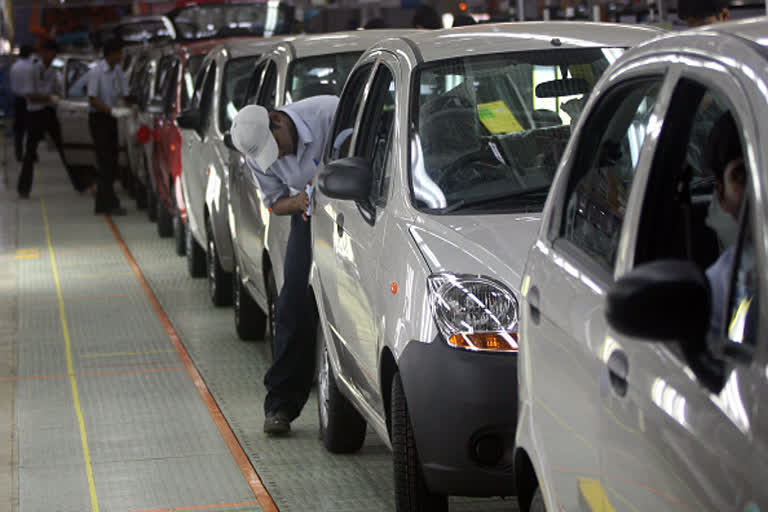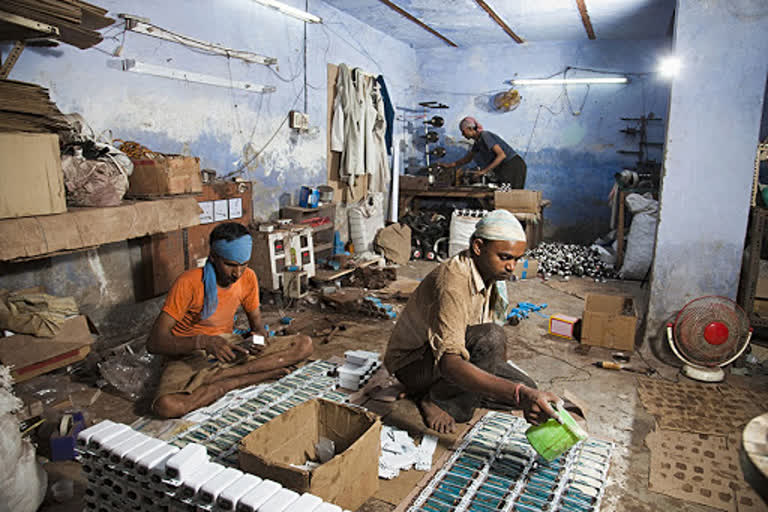Hyderabad: Any discussion on the present state of Indian economy and way forward revolves around Covid-19 pandemic which apparently not only has a health contagion effect but a global economic crisis as well.
Although such analysis concentrates mainly on economic stimulus package announced by the central government in several installments since March, 2020, the real flavor of this can only be found if one brings the immediate pre Covid-19 economic situation in India.
Indian economy nosedived in terms of growth of real GDP at market prices from 7 per cent in 2017-18 to 5 per cent in 2019-20 (Advance estimate). Most importantly manufacturing sector’s growth fell from 6.6 per cent to 0.9 per cent in the same period.
Along with that food prices had a steep rise for the better part of 2019-20 while India’s non-oil imports had a significant fall of 9.5 per cent on account of economic slowdown. Bank credit growth declined by more than 7 per cent in 2019-20 compared to the previous year’s growth as well as investment growth declined in 2019-20. Indians saved around 34 per cent of their income in 2011-12 which declined to around 30 per cent in 2017-18.
So even before Covid-19 hit India in March 2020, Indian economy was showing great stress in the last financial year. The major manufacturing industries like automobile, durable consumer goods and engineering goods showed rapid decline in growth along with construction.

One must note that growth of services sector depends a great deal on the growth of manufacturing and construction sector too. The main reason advanced by the industries (large and small alike since in the present days of value chain, they are linked) was lack of demand.
Consumers were not buying, so with unsold stocks industry was unwilling to borrow and invest. These two are major source of domestic demand. Exports also showed rapid decline since the US-China trade war along with Brexit uncertainty in UK and Europe created decline in global demand. So even before Covid-19 raised its ugly head, the government announced sometime in January 2020 major cuts in corporation tax worth Rs 1.45 lakh crores, Rs 50,000 duty refund scheme for exporters along with sops for telecom and housing sectors.
So, the problem of dearth of demand for the domestic sector, especially manufacturing and construction, was already having its toll on Indian economy even before Covid-19 started impacting the society and economy in India.
The government tried to boost demand through tax cuts and subsidy, a typical Keynesian type prescription. Why was there such a decline? One major reason for this is certainly the rising inequality, especially in the expanding urban sector in India.
This rising inequality put more money in the hands of those who did not spend but used it for non-productive investment like gold or land or other dubious tax avoiding deposits abroad. Along with that, the falling demand had a cumulative negative effect on employment (especially the MSME sector which provides 40 per cent of total employment), leading to uncertainty among a large section of casual and contract workers.

This uncertainty prevented households to spend freely even if they earned since they had saved thinking about future days. Along with that the uncertain global demand provided the last straw to this depressing scenario.
So what the lockdown and stoppage of production activity due to Covid-19 did was to overturn any signal the economy was showing of a mild recovery since February 2020. The lockdown created the space needed for the public health system to gear up for coping up with the disease as well as preventing a catastrophic spread of the virus among the population.
But the lockdown simply threw a vast majority of daily workers (residents plus migrants) out of their jobs and created more uncertainty in the economy. Thus the already falling aggregate demand in the economy experienced a much steeper fall due to the advent of Covid-19 in India.
Read more: Defer avoidable expenditure, reduce costs: Govt tells public sector banks
The industry, especially the MSME sector already reeling under lack of demand, got a further jolt and the risk-aversity of the entrepreneurs prevented them from undertaking any additional investment.
The steps taken by the government of India consisted of an uncommon mix of fiscal stimulus, monetary expansion and economic reform. The fiscal stimulus amounting to roughly Rs 2 lakh crores (about 1 per cent of our GDP) is basically putting money in peoples’ hand so that they could demand food and non-food items, noting that now about 60 per cent of total spending is on non-food items.

About Rs 17 lakh crores of the package is proposed expansion of liquidity in the economy in terms government guaranteed credit (a large part to MSME sector) and expanded liquidity of commercial banks through RBI policies. The last part of the phased stimulus is pushing economic reform in agriculture, power sector and privatization of public sector units.
So one can clearly see the post Covid-19 economic policy of the government is continuation of demand boosting steps taken in the pre Covid period. One may question the mix of different kinds of policies in this regard.
Direct transfer of cash through fiscal stimulus is an immediate demand boosting measure (if it truly goes to the bank accounts of the beneficiaries) but not so for more liquidity through monetary expansion since the latter works only when the industry or households starts taking credit for investment. This obviously works in a longer term and is a doubtful starter in an environment of risk and uncertainty. The push for economic reform in a period of distress of people may not be very welcome even if they bring long term benefits.
The biggest policy which may bring sustainable benefit in a medium and long term is the wise reform taken to increase the upper limit of MSME sector to Rs 200 crores in terms of turnover.
Given that in the last budget, an announcement is made to make India an assembly hub, such an increase in scale may allow Indian MSME manufacturers in automobile, engineering, electronics, pharmaceuticals, chemicals, readymade garments, leather and food processing industries to be linked to the global value chain (GVC) or global supply chain.
This has become a distinct possibility since the initial disruption of supply chain in China (assembling as well as parts and component production) has led a number of countries in Europe, Japan, USA and Korea to look for alternative locations.
This is truly a post Covid-19 opportunity which needs to be explored by India aggressively through offering tax breaks, easy credit, world class infrastructure in terms of roads, ports, power and land (preferably in PPP mode to allow ownership by private sector too) and good governance. In addition the industry associations must undertake aggressive marketing in tandem with Indian missions abroad to compete with other south-east Asian nations.
(Written by Professor Ajitava Raychaudhuri, former Head of Department of Economics, Jadavpur University. Views are personal.)



